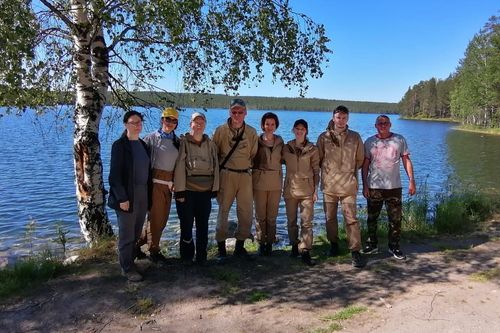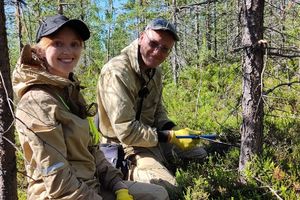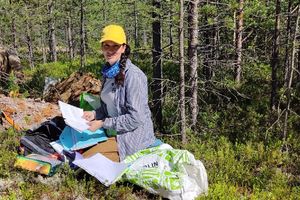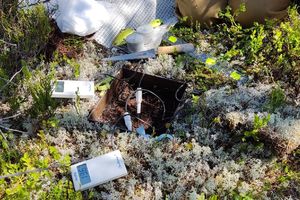The field trip was part of a three-year project funded by the Russian Science Foundation. The project's principal objective is to study the molecular genetic and physiological-biochemical mechanisms in pith wood formation in Scots pine – a dominant tree species in Karelia and one of the main forest species in the European taiga.
The pith is the inactive region in the center of the tree trunk. In a sawn section of a pine tree, it usually looks darker than active wood (sapwood). Pith wood is resistant to biodegradation owing to special extractive substances, which generate the color when oxidized in the air. That is why it is not uncommon to see trees in the woods with the exterior part already destroyed and the interior still intact. Sapwood participates in transporting water from roots to the crown while pores in pith wood are sealed, so it does not perform any visible physiological functions. Pith in the tree is largely responsible for resistance to windstorms and for timber quality: moisture, color, and strength.
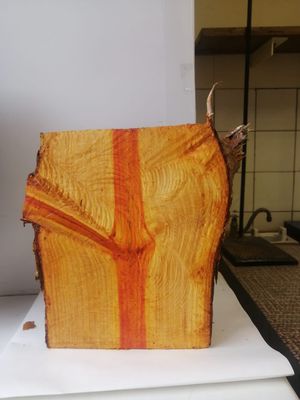
The central part of the section is the pith (color highlighted)
Pith wood study is a young research area in global science. Activities peaked in the early 2000s. Since pine has well-developed pith wood, the species is regarded a convenient object for studying this unique biological phenomenon. Previous studies have mostly focused on the physiological and chemical characteristics of pith wood and its anatomical features. As molecular genetic methods have become available, a new stage is beginning in the study of pith wood formation patterns. Armed with the new methods and the background from research on this tree species, FRI KarRC RAS has the chance to contribute to basic science. The results of the project will have practical value as well: knowledge about the molecular genetic mechanisms regulating pith wood formation has potential applications in tree cultivation for timber with desired properties.
Also, scientists study pith wood formation patterns in different climatic settings – northern and middle taiga subzones, forest types with different moisture conditions, soil fertility and structure (bilberry-type – cowberry-type – lichen-type pine stands). The results of this work will help predict what will be happening to pine timber under global climate change.
The first project results have already been published in large international journals. Scientists have proved, e.g., that pith wood formation rate in Scots pine is controlled by the age of the tree (or, more specifically, the cambium – its formative tissue) and does not depend on the external environment. This rate is on average 0.3 rings per year in 20–30-year-old trees, 0.4-0.5 in 70–80-year-old trees, and approximately 0.7 rings per year in 180-year-old trees. An effective mathematical model has been produced for predicting the number of annual rings in pine pith.
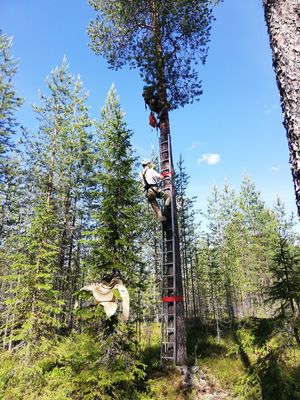
Natalia Galibina and Sergey Moshnikov working at height on tree trunk
– We have also found that the zone of transition between sapwood and pith wood is always two annual rings – irrespective of the site conditions. It is in this transitional zone that the major events leading to pith wood formation take place: pore sealing and tissue dewatering begins, extractive substances are synthesized in parenchyma cells, nuclei are degraded causing cells to die (programmed cell death). As part of investigating these processes, we study upregulated enzymes and genes, – explains Natalia Galibina, Project Leader, Chief Researcher at the Laboratory for Woody Plant Physiology and Cytology FRI KarRC RAS.
Scientists have already identified the genes in pine genome that launch programmed cell death and compared the modes of their operation in different wood tissues.
Finally, one more important application for the study is investigation of carbon storage in forest ecosystems. Carbon absorbed from the atmosphere is incorporated through metabolic processes into cell structural components as part of complex organic compounds and can remain thus sequestered within woody plant tissues for a long time. Most of the carbon is stored in wood. In the calculations of carbon storage by forest ecosystems, its content in wood is usually estimated at 40–45%. Karelian scientists have demonstrated that carbon content in pith wood is higher than in sapwood – approximately 50%. Preliminary calculations for a bilberry-type pine stand show that pith wood in 80-year-old trees already amounts to 45–50%. Another important consideration is that owing to the presence of extractive substances that promote resistance to biodegradation, pith wood decay after tree death is a lengthier process. Thus, pith wood contribution to long-term sequestration or neutralization of carbon has so far been underestimated and requires closer attention. Further studies can lead to a revision of the role of old-growth boreal forests in the global carbon balance.
Photos by Nadezhda Genikova, Yulia Moshchenskaya / Forest Research Institute KarRC RAS




